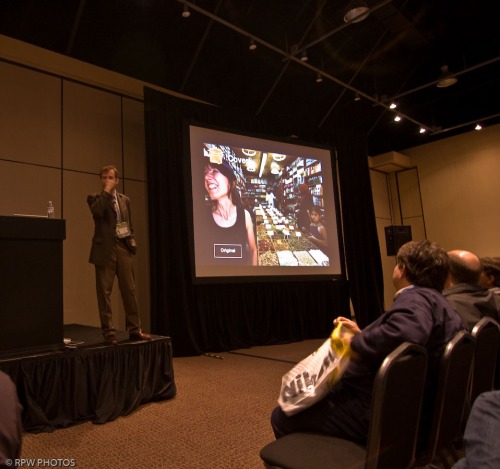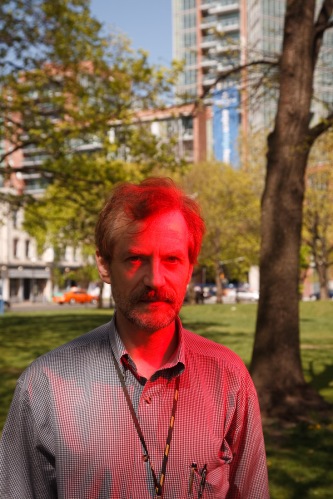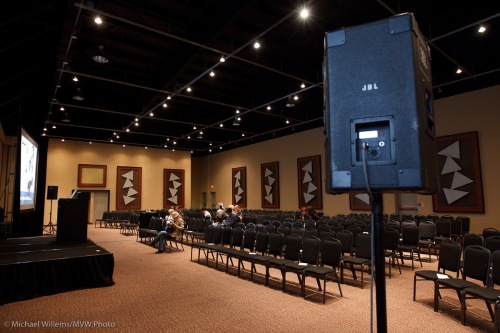A reader just emailed me, telling me she recently attended a course for her Nikon D5000 camera, and says:
“I will be attending a fundraiser in Oakville this evening and bringing my camera (of course). I am have a bit of difficulty firstly with indoor dimly lit lighting and secondly I am looking to create the look of my subject which is focused and the background is faded. I am having many, many other problems, but for know if you could help out with those two that would be splendid!”
Let’s see if I can help. Of course there is a lot to learn (it’s what photographers spend years learning), but I am sure some quick tips will be of use.
First, you want photos like this:

Gregory Talas at The Kodiak Gallery
In other words, photos where the background is well-lit by available light (not under-lit) and the subject is well lit by your flash (not over-lit).
Here’s some starters, then.
- Lens: You will probably want a “slightly wide angle” lens setting. This is a “real” lens setting of 35-45mm: that is a setting between 24 and 30mm zoom on the lens on your crop-factor camera (see the dial on the lens)
- ISO: Set your camera to 400 ISO, or 800 ISO if it is darker or the ceilings/walls are far away. or your pictures turn out too dark.
- Mode and settings: Select “Manual” exposure mode (“M” on the dial on top ) and choose a shutter speed of 1/30th second if it is dark (1/60th if it is bright). As for Aperture, select the lowest “F”-number you can go to (e.g. 3.5 or 4, depending on your lens; as low as 2.8 or even lower on a professional lens).
- If the previous step is difficult you can just use Program Mode, “P”.
- Flash: Turn on your SB-600 or SB-900 flash (you do have one, right?) and ensure you have fresh batteries, and spares.
- Bouncing: Above all: if at all possible, try to bounce the light off the wall/ceiling behind you.
What are we doing here?
- The wider angle is suitable for events, and makes it easier to shoot at low shutter speeds.
- high ISO and slow shutter speed give you a well-lit background
- The low “F”-number gives you your blurry background.
- The bouncing gives you nice, soft shadows and avoids overexposing your subject with harsh, flat, horrible direct flash light. It also avoids red-eye.
I hope that helps.
Please do search the blog here for terms like “bounce flash” and “events”, and scroll down and select the “FLASH” keyword and browse through those articles. Ignore the advanced ones, just read the ones that speak to your situation. Here’s a few samples:
And that’s just a quick search. This blog is a useful resource, if I say so myself, if you use the search function.
And as for your event: above all, have fun! Tell people “heads together” when you shootthe “grip and grins”. And enjoy making them smile.
And finally: take more courses. That’s what they are for, and you will be amazed at how few three-hour courses you actually need to learn photography. See you in class!













